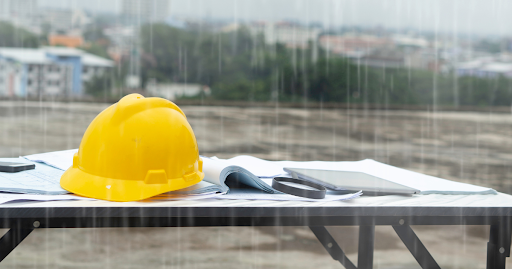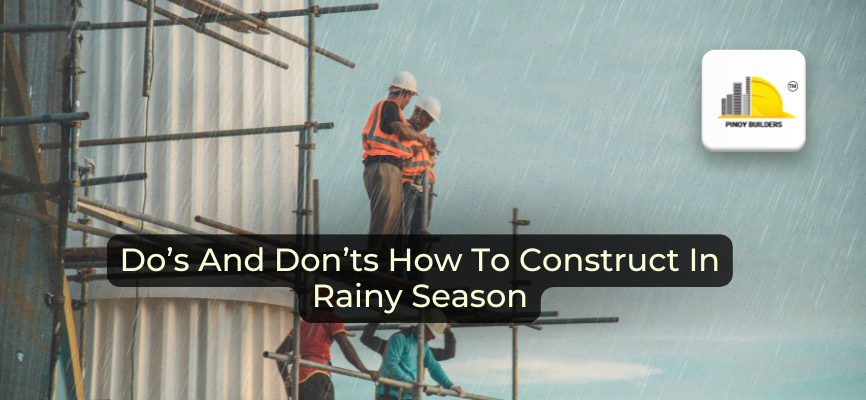Have you ever wondered how the rainy season impacts construction projects? While the rain can be a welcome change in some parts of the country, it also presents significant challenges for construction projects. Constructing during the rainy season might seem like a daunting task. Still, with the right approach, it can offer unique opportunities for cost savings and efficiency.
In this article, we’ll cover essential do’s and don’ts for successful construction during the rainy season, focusing on proper planning, preparation, and risk mitigation.

Challenges of Constructing During the Rainy Season
Rainy weather can lead to a host of issues on a construction site:
- Delayed Timelines: Constant rain can cause work stoppages, leading to delays and extended project timelines. Heavy rain can heavily impact activities such as pouring concrete and painting, causing scheduling headaches.
- Structural Integrity Concerns: Excess moisture is a common enemy of building materials. For example, concrete may not set properly, and wood can warp or rot, compromising the quality and safety of the structure.
- Safety Hazards: Wet surfaces increase the risk of slips and falls, which could lead to injuries. Additionally, handling electrical equipment in wet conditions poses significant risks.
- Soil Stability Issues: Saturated soil can become unstable, leading to problems such as erosion, landslides, or an inadequate foundation, all of which can compromise the integrity of the construction.
Importance of Proper Planning and Preparation
Effective planning is crucial to reducing the impact of rain on construction projects. Conducting a detailed site assessment can reveal drainage patterns and areas susceptible to waterlogging, enabling strategic placement of materials and equipment. Monitoring weather forecasts allows for scheduling around days with heavy rain, thus avoiding delays and safety issues.
It’s also important to store materials under waterproof covers or in dry, secure locations to prevent damage. Also, having contingency plans ready, such as reallocating resources or extending deadlines, ensures that any disruptions due to weather can be effectively managed.
Do’s for Constructing During the Rainy Season
- Do Use Waterproof Materials: Utilize weather-resistant materials for exterior works to minimize water damage. This not only preserves the quality of the structure but also helps maintain timelines.
- Do Implement Drainage Systems: Install temporary or permanent drainage solutions to manage water flow and prevent flooding on the construction site.
- Do Secure the Site: Use tarps, temporary roofing, or other protective measures to shield unfinished structures and materials from rain.
- Do Train Workers on Safety Protocols: Educate workers on safety measures specific to wet conditions, such as using non-slip footwear and handling equipment safely.
Don’ts for Constructing During the Rainy Season
- Don’t Ignore Small Leaks or Water Damage: Small leaks can quickly turn into major problems if left unchecked. Addressing these issues immediately prevents costly repairs and delays.
- Don’t Overlook Ground Conditions: Operating heavy machinery on saturated soil can lead to compaction and accidents. Avoid these activities until the ground is stable.
- Don’t Rush the Process: While it’s tempting to speed up construction to avoid severe weather, hasty work can compromise quality and safety.
- Don’t Disregard Environmental Impact: Construction practices should be environmentally responsible. Avoid causing erosion or damage to the surrounding area due to poor planning.
Potential Benefits of Constructing During the Rainy Season
Despite the challenges, there are also advantages to building during the rainy season:
- Workforce availability: With fewer projects scheduled, there may be a larger pool of available workers.
- Cost Efficiency: Some materials and services may be cheaper during the off-peak rainy season due to lower demand.
- Time Management: Completing projects during the rainy season can free up resources for other projects when the weather is more favorable.
Constructing during the rainy season presents both challenges and opportunities. By focusing on proper planning, risk mitigation, and adherence to safety protocols, it’s possible to navigate the rainy season successfully.
Remember, the key is to be prepared and proactive. Consult with professionals to ensure your construction projects are well-equipped to handle the unique demands of the rainy season, leading to efficient project completion and potential cost savings.










